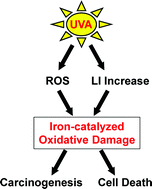 A recently published perspective from Charareh Pourzand, Rex Tyrrell, co-editor-in-chief of PPS, and co-workers at the University of Bath gives an overview of recent findings on intracellular labile iron (LI) distribution and trafficking. Using UVA radiation as an example, it also discusses mechanisms and consequences of oxidant-induced alterations in the intracellular pool of LI. This perspective forms part of an upcoming themed issue on UVA.
A recently published perspective from Charareh Pourzand, Rex Tyrrell, co-editor-in-chief of PPS, and co-workers at the University of Bath gives an overview of recent findings on intracellular labile iron (LI) distribution and trafficking. Using UVA radiation as an example, it also discusses mechanisms and consequences of oxidant-induced alterations in the intracellular pool of LI. This perspective forms part of an upcoming themed issue on UVA.
Iron is a vital nutrient and is required for a wide variety of cellular processes due to its facile redox chemistry and affinity to oxygen. However, when the redox-active chelatable ‘labile’ form exceeds the normal binding capacity of the cell this labile iron (LI) can become toxic. In the presence of reactive oxygen species LI can catalyse the formation of oxygen-derived free radicals that overwhelm the cell’s antioxidant defence mechanism and result in cell damage. Although intracellular iron homeostasis is tightly regulated acute exposure of skin cells to UVA induces an increase in intracellular LI and this appears to play a key role in the increased susceptibility of skin cells to UVA-mediated oxidative membrane damage and necrotic cell death.
To find out more follow the link below. Full text is FREE until November 11th.
Iron, oxidative stress and the example of solar ultraviolet A radiation
Asma Aroun, Julia Li Zhong, Rex M. Tyrrell and Charareh Pourzand
Photochem. Photobiol. Sci., 2012, DOI: 10.1039/C1PP05204G










